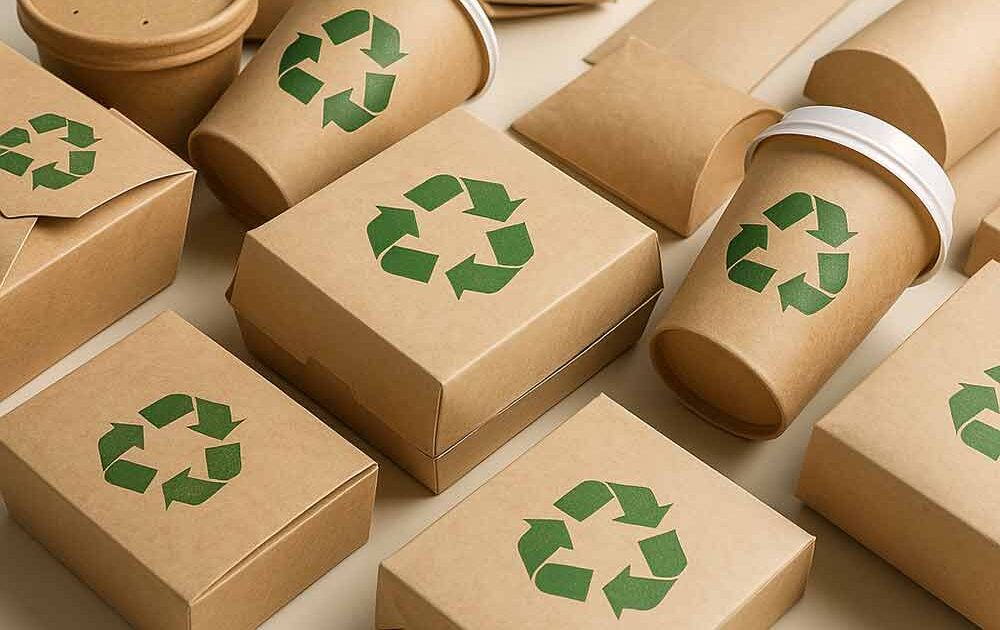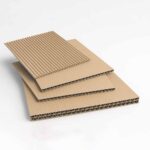What is sustainable packaging?
Sustainable packaging is a type of packaging that is eco-friendly and safe for the environment. It is essential in today’s world because it minimizes harm to the environment by reducing waste.This type of packaging utilizes biodegradable, recyclable or reusable materials, promoting a circular economy while maintaining product safety. It also helps conserve natural resources and significantly reduces pollution. Unlike plastic, which takes centuries to degrade, sustainable alternatives offer an effective solution to the global plastic waste crisis.
Some key facts about packaging which is sustainable:
There are a lot of interesting facts regarding sustainable packaging, here are some of them:
- Sustainable packaging can decrease carbon emissions by 30-80%
- Such packaging materials can cut the waste up to 80%
- 74% of consumers are willing to pay more for sustainable packaging
- 81% of people prefer brands with sustainable packaging
- Sustainable packaging materials for e.g bioplastics emit 75% less CO2, cardboard has the highest recycling rate, aluminium has 74% recycling rate.
- Production of sustainable materials needs less energy and water consumption as compared to other materials
How packaging affects sustainability of our environment and planet?
Packaging causes a lot of harm to our environment, ecosystems, natural habitats and human life. Bad choices of packaging materials has put us all in danger, we are contaminating our planet gradually. Following are some points which will help us understand better about what is actually happening to our planet.
-
Accumulation of plastic:
Unfortunately, most of the plastic that we use for packaging cannot be recycled. About 79% of all plastic packaging waste accumulates in landfills.
-
Effects on climate:
The process involved in the production of packaging starting from its manufacture to its shipping, toxic gases are released during the process which contributes to greenhouse gas emissions, up to 1.8 billion tons of greenhouse gases are emitted yearly due to plastic packaging production. Due to this we are experiencing extreme climate changes around the world.
-
Effects on natural resources:
A large quantity of natural resources is used during the production of packaging materials, for e.g water and minerals, therefore it plays a major role in depleting our natural resources. We are gradually running out of clean water, minerals and clean food. Without natural resources, our quality of life will be at extreme risk.
-
Effects on marine life:
Plastic coming from packaging materials has impacted aquatic life to a great extent. 23 million metric tons of plastic waste entered the ocean in just one year. It puts a risk on marine life as well because many animals get stuck in plastic waste. Every year sea animals like turtles, fish, sea birds, are found stuck badly in plastic waste, and get injured so badly that they can’t even move and slowly starve to death.
-
Effects on land wildlife:
As plastic waste accumulates on land, animals either consume it by mistaking it for food or they just get entangled in it, leading to deaths of elephants, tigers and other vulnerable species. It is putting a number of species at risk. Unfortunately we have many endangered species around the globe and moving to better choices of packaging material can help save them.
-
Effects on soil:
As we all know that some worms like earthworms, nematodes and snails are crucial for maintaining soil quality, microplastics present in soil enter their body and cause death, leading to their loss and poor soil quality which is not able to grow crops. Also this polluted soil pollutes the water we drink and animals we eat. Through soil, the microplastics are entering animal bodies, human bodies and also the vegetables and fruits that we rely on are getting polluted.
-
Effects on human health:
We are not even aware of how much plastic we are consuming.Yes,you heard it right, microplastics are becoming a part of our body. This is causing poor digestion and many other negative health effects. They also cause hormonal disturbances in humans for e.g Bisphenol A (BPA) and phthalates.Some of fatal conditions like heart attack, stroke, colon cancer and ADHD may come from microplastic exposure. A good example of this is when microplastics are found in newborns, how did the plastics get into newborns? Of course through food that the mother consumed.
Why is there a need for sustainable packaging?
If we want to save ourselves in future, we need to act now.Our planet is in danger due to the excessive accumulation of waste, the majority of which comes from plastic packaging materials. Plastic items can take up to a 1000 years to decompose,and even then, they break down into microplastics that pollute land and water. These microplastics pose a serious risk to wildlife, humans, and natural resources.. Switching to sustainable packaging is not just a choice,it’s an urgent necessity.
How sustainable packaging is cost effective?
We might think that it will cost us more to switch from our current materials used for packaging to more sustainable materials, but it is actually the opposite. If we start using materials that are reusable and recyclable, we can save a lot of money.Also, many consumers are willing to pay more for sustainable packaging so there is no loss if we decide to start using sustainable materials.Switching to sustainable packaging is actually cheaper than we think, Here’s how:
-
Cheaper raw material:
Recyclable cardboards, plastic, paper, all of these cost way cheaper than virgin materials. In a sustainable design, minimal packaging material is used which automatically reduces cost. Similarly biodegradable options are cheaper as compared to plastic. It is as simple as that, use cheaper sustainable material to reduce overall production cost.
-
Reduced transportation cost:
When light weight materials are used in packaging, they are easy to handle and transport and therefore transportation is less expensive. Compact designs and light weight packaging also takes up less space during transportation and cuts extra logistics costs.
-
Reduced waste disposal fee:
When recyclable materials are used in packaging, they don’t need to be wasted and the cost of waste disposal trims down. For example many people use empty packaging containers in their homes for storing anything they want, glass jars are refilled and reused and are easily recycled, metal tins can be reused for storage. So no need for disposal reduces disposal cost significantly.
-
Decrease in repurchasing cost:
The materials which are reusable for e.g glass, aluminium, metal and durable bioplastics can reduce repurchasing cost as they do not need to be purchased again and again. They can be collected after use and can be recycled to be used again. For e.g glass bottles are collected and renewed.
7 tips of moving to sustainable packaging:
Many brands are now incorporating sustainable packaging into their business models. Fortunately, we have numerous economical alternatives to plastic, that can be easily adopted:
-
Use of recyclable materials:
We can use materials that can be collected after use and recycled for reuse,such as cardboard, paper bags, aluminium or glass.These options are easily recycled and keep our environment clean.
-
Use of biodegradable materials:
These materials break down into simpler, non-toxic components making them eco-friendly. Examples include bioplastics, compostable paper,mushroom packaging, cornstarch packaging. These options decompose naturally and therefore reduce waste.
-
Use of reusable materials:
These can be used multiple times by consumers, extending the life cycle of packaging. For e.g glass jars, metal tins, can be refilled and repurposed. Stainless steel can be used as food containers and insulated packaging. Paperboards, fabric based materials like jute, wood and reusable plastic are some other options.
-
Avoiding excessive packaging:
Sometimes there is no need to add extra layers to packaging, this only leads to more waste products at the end. So by keeping it minimal, we can make it more sustainable.
-
Using lightweight packaging:
This step can be a gamechanger when it comes to packaging. Lightweight packaging takes up less space and is easy to carry, it reduces the end product of waste to a large extent, thus making it more sustainable.
-
Use of sustainable inks while printing:
Petroleum based inks result in an increase in chemical waste. Instead, we can use some options which are biodegradable such as, water based inks, vegetable based inks or soy based inks.
-
By spreading awareness:
By making efforts to educate people about how important sustainable packaging is, we can promote it easily. We can add a recycling logo on our packed products and encourage responsible disposal.
By transitioning from using plastic to these eco-friendly alternatives, we can effectively manage waste and reduce our carbon footprint. The key is to make conscious choices that benefit both the environment and future generations.
Advantages of sustainable design in packaging:
Sustainable packaging benefits the environment, consumers, and businesses alike.. If we talk about the environment, there will be:
- reduction in waste
- Conservation of natural resources
- Less carbon footprint (greenhouse gases)
- Protection of wildlife
Similarly, it has advantages for business owners such as:
- Cost effectiveness, less shipping and packaging cost.
- Good brand image in the eyes of eco-conscious customers
- Keeping environmental standards in notice
Consumers also benefit from such packaging because:
- It’s a safe and healthy option, many plastics are a danger to health as they contain chemical additives.
- Consumers can reuse such packaging and utilize it
- A sense of satisfaction and responsibility
Additionally, sustainable packaging helps protect wildlife, as many animals suffer injuries or fatalities due to plastic waste accumulating in their natural habitats.
Who else is using the idea of sustainability of their packaging?
There are many companies out there which are using eco-friendly packaging materials for their products to put the least negative impact on the environment. Few of such brands are mentioned below:
- ‘Nestle’ is using biodegradable water bottles which are made from plant based materials. They are also bringing in paper based food wrappers.
- ‘Adidas’ committed to using 100% recycled polyester and recycled ocean plastic.
- ‘Loreal’ is using paper based tubes for their cosmetics
- ‘Ikea’ is using mushroom based packaging instead of styrofoam.
- To reduce plastic waste ‘The body shop’ launched refill stations. They use 100% recycled plastic in many product bottles.
- Amazon took an initiative of frustration free packaging, which reduces waste of plastic. They use paper-padded mailers instead of bubble wrap.
Similarly many other brands are taking this initiative of moving to sustainable packaging as it’s not only good for the environment but also it is cost effective and attractive to customers.
Conclusion:
By making the right choices today, we can create a greener future for generations to come.This issue requires global attention and action, and we must support brands that prioritize sustainable packaging.While significant damage has already been done, it is not too late to reverse the effects through worldwide efforts. Every step towards sustainability brings us closer to a cleaner, healthier planet.
Business owners, consumers and policy makers must make a collective effort to make it happen and ensure long term sustainability. It’s not about putting a recycling logo on our packaging, it’s about making sincere efforts to make our packaging material sustainable. The good part is that sustainable packaging is more cost effective, so there will be more profit for business owners when they switch to it. You can save a lot of money by just changing the packaging material.
As many leading brands are already investing in sustainable packaging, their commitment to eco-friendly practices has contributed to their strong market presence and reputation. With increasing consumer demand for environmentally responsible products, sustainable packaging will soon become the industry standard. Adopting these practices early not only meets customer expectations but also enhances brand image and long-term competitiveness. The sooner businesses take action, the greater the benefits for both the environment and their success.




